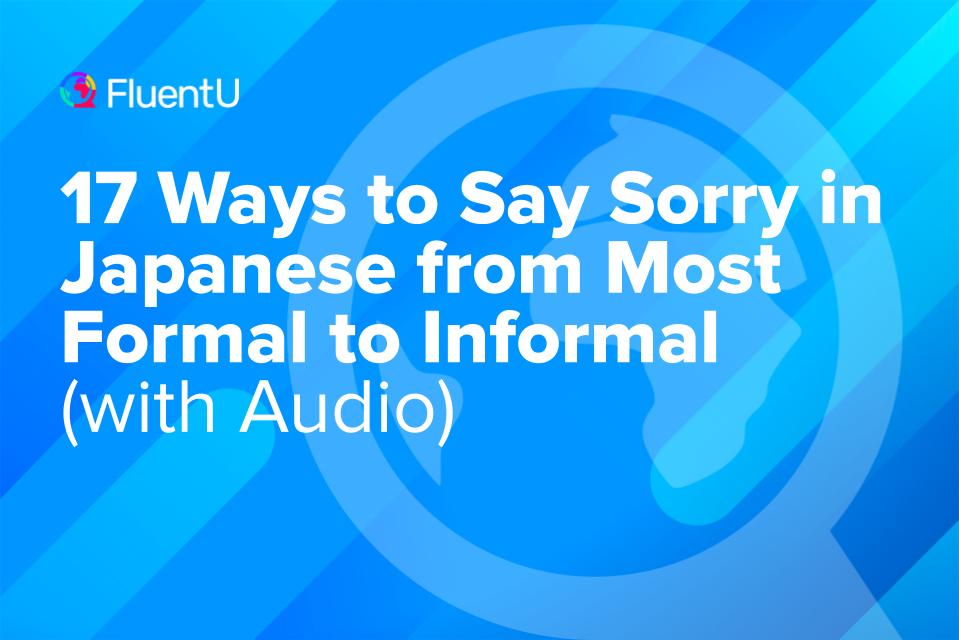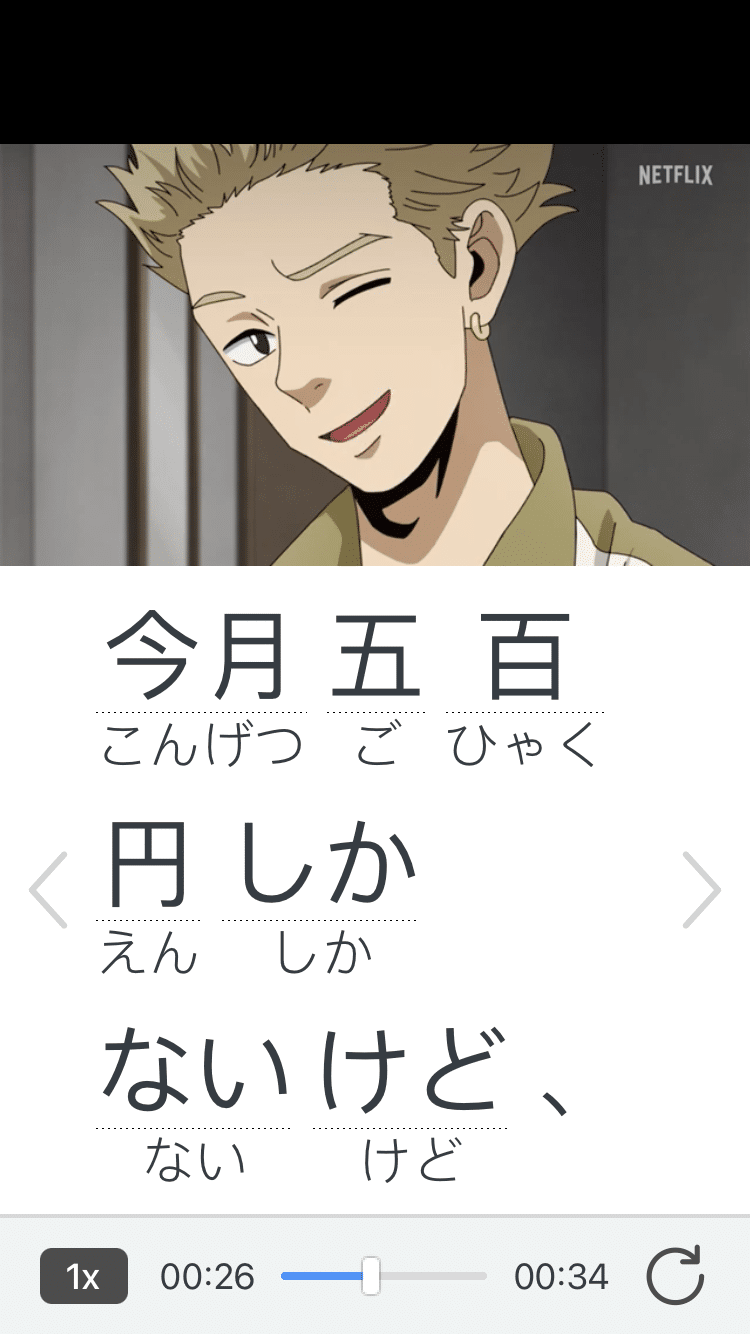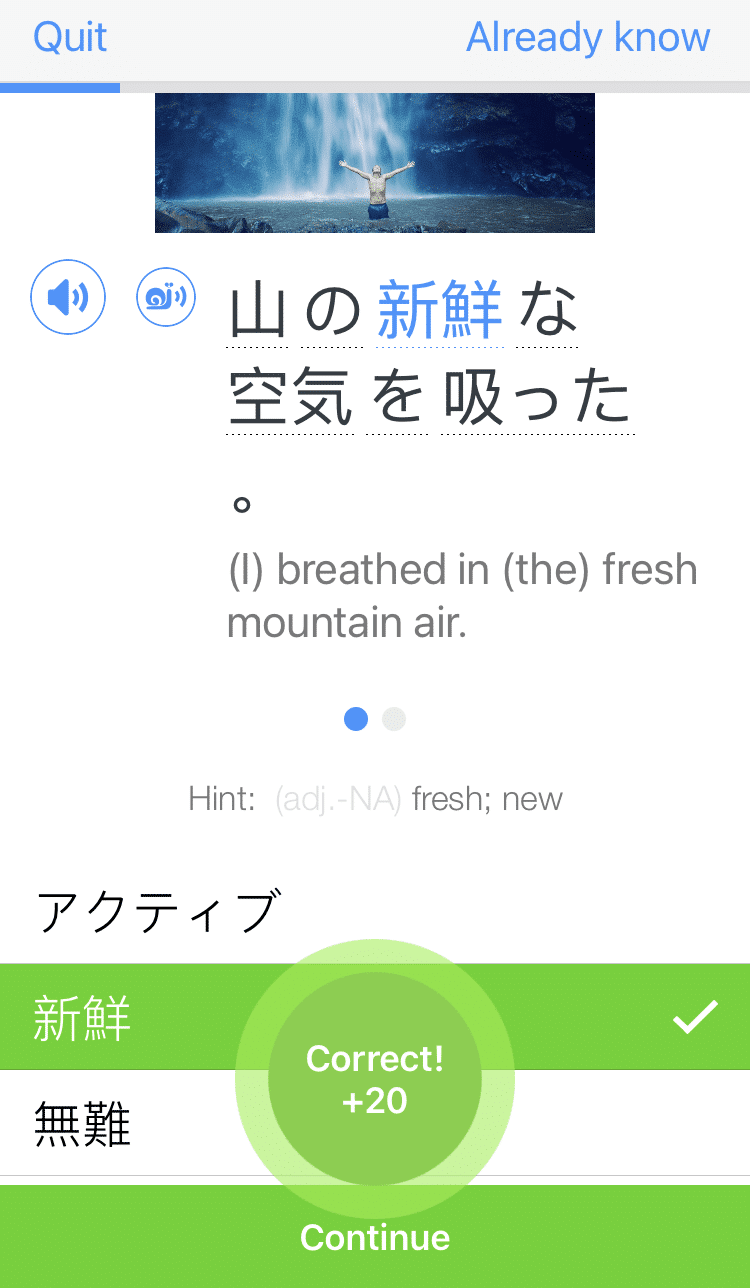Contents
- How to Say “Sorry” in Japanese
- 1. ごめんなさい — Sorry
- 2. 本当にごめんね — I am so sorry
- 3. すみません — Excuse me
- 4. お邪魔します — Excuse me for bothering you
- 5. 謝罪いたします — I apologize
- 6. 失礼します — Excuse me, please
- 7. これは失礼しました — I’m sorry about this
- 8. 本当にごめんなさい — I am really sorry
- 9. ご面倒をお掛けして、すみません — I’m sorry for all the trouble
- 10. どうもすみません — I am so very sorry!
- 11. 申し訳ありません — I feel awful
- 12. 許して / 許してください — Forgive me / Please forgive me
- 13. 勘弁して / 勘弁してください — Show me mercy / Please show me mercy
- 14. お詫びします — I apologize
- 15. 合わせる顔がない — I cannot face you
- 16. 弁解の余地がない — There is no excuse
- 17. すごい ごめんね — I am truly very sorry
- How to Respond to an Apology in Japanese
- When Is It Appropriate to Apologize in Japan?
- And One More Thing...
17 Ways to Say Sorry in Japanese from Most Formal to Informal (with Audio)

Japanese apologies can be incredibly nuanced.
It’s important to know which one to use when and when to use a formal or informal apology.
But we’ve got you! Read this post to learn about 17 key ways to say sorry in Japanese, so you’ll never be stuck in an uncomfortable situation! Let’s learn the art of the Japanese apology.
Download: This blog post is available as a convenient and portable PDF that you can take anywhere. Click here to get a copy. (Download)
How to Say “Sorry” in Japanese
1. ごめんなさい — Sorry
Formality: Informal
This is definitely the most common way to apologize in Japanese and is a sort of catch-all term.
Generally, if you use this phrase in a situation that calls for a different apologetic phrase, most Japanese speakers will know what you mean.
However, it’s considered rude to use this phrase to apologize to superiors and real fluency means learning all the nooks and crannies of a language!
2. 本当にごめんね — I am so sorry
Hiragana: ほんとうに ごめんね
Formality: Informal
This very heartfelt apology is typically used between best friends or between men and women. When you screw up in a romantic situation or when you’re with someone you’re crushing on, this would be a good way to apologize to them.
3. すみません — Excuse me
Formality: Informal
This is one of the most common ways to apologize in Japan. It’s used as a more lax apology, such as when you bump into someone on the street or commit a very mild social faux pas.
すみません often seems interchangeable with 御免なさい, but it’s not: すみません can be used in a non-apologetic situation while ごめんなさい is strictly used for apologizing.
4. お邪魔します — Excuse me for bothering you
Hiragana: おじゃま します
Formality: Informal
Another way of reading this is as “excuse me for disturbing you” or “sorry for interrupting you.”
Use this phrase if you suddenly have to visit someone’s home or if you’re promoting something door-to-door. It can also be used when calling someone on the phone.
5. 謝罪いたします — I apologize
Hiragana: しゃざい いたします
Formality: Formal
This is a formal way of apologizing typically seen online or in print from celebrities or politicians who did something scandalous.
6. 失礼します — Excuse me, please
Hiragana: しつれい します
Formality: Formal
Roughly, this could be seen as a way of saying “Oh, I’m rude” or “Oh, my mistake.”
It’s used less as a way to apologize and more as something you’d say when reaching past someone, entering a room or hanging up the phone.
7. これは失礼しました — I’m sorry about this
Hiragana: これは しつれい しました
Formality: Formal
This phrase is similar to 失礼します but holds a bit more stock. It’s a formal way to apologize to a co-worker or a stranger if you genuinely feel like you screwed up.
Say you bumped into a coworker at the office that you’re unfamiliar with and knock the binder right out of his arms. While helping him pick it up, you’d say これは失礼しました.
8. 本当にごめんなさい — I am really sorry
Hiragana: ほんとうに ごめんなさい
Formality: Informal
It’d be wise not to use this with teachers or people of authority, but rather strangers and friends. It’s usually used when an innocent mistake is made but you feel really terrible about it.
9. ご面倒をお掛けして、すみません — I’m sorry for all the trouble
Hiragana: ごめんどうを おかけして、すみません
Formality: Formal
Remember how we mentioned that you should apologize in an office setting when someone does something helpful for you? This is the phrase to use.
This isn’t you throwing yourself at their feet and begging for forgiveness. Rather, it’s a formality, a way to thank someone in a Japanese way.
10. どうもすみません — I am so very sorry!
Formality: Informal
The mix of どうも — thanks and すみません makes this phrase seem a little strange. How can you thank and apologize to a person all at once? This phrase is used in situations where somebody helps you out with a small task.
A friend pours your tea at lunch. A coworker brings you a file you needed. It’s definitely more of a way of saying “thanks” than apologizing.
11. 申し訳ありません — I feel awful
Hiragana: もうしわけ ありません
Formality: Formal
This is a very formal phrase used to apologize to a superior at work, a police officer or somebody else that has authority.
It can also be used as a formal way to show extreme gratitude for something. This phrase is similar to これは失礼しました but conveys much more intensity and is only used when apologizing to authority figures.
12. 許して / 許してください — Forgive me / Please forgive me
Hiragana: ゆるして / ゆるしてください
Formality: Informal
Use this phrase when someone’s upset with you, whether it’s a friend, a stranger or a person of authority.
It’s a good expression to use if you want to avoid “losing face,” as yelling at someone and making a scene in Japan is considered a major social faux pas. If you’re calm and asking for forgiveness, you look a lot better.
13. 勘弁して / 勘弁してください — Show me mercy / Please show me mercy
Hiragana: かんべん して / かんべんして ください
Formality: Informal
This may seem similar to 許して but it’s actually a lot more intense.
If you royally screw up, such as by cheating on your spouse or being responsible for something catastrophic, you’d say 勘弁して / 勘弁してください and probably also dramatically hit your knees.
Someone who’s completely wracked with guilt would use this phrase.
14. お詫びします — I apologize
Hiragana: おわび します
Formality: Formal
This is probably the most intensely formal way of apologizing in Japan.
It was famously used by former Prime Minister Murayama in his apology to the world for Japan’s involvement in World War II. That’s the level of screw-up you need to use this one.
15. 合わせる顔がない — I cannot face you
Hiragana: あわせる かおが ない
Formality: Informal
This can also be read as “I am too embarrassed to face you.”
The expression can be used interchangeably with 弁解の余地がない but it’s mostly used when apologizing via text or email, hence the “too embarrassed to face you” meaning.
16. 弁解の余地がない — There is no excuse
Hiragana: べんかいの よちが ない
Formality: Informal
This would be used when you mess up and there really isn’t any excuse for what you did. If you hurt your spouse’s feelings or got caught doing something really shady, use this term.
17. すごい ごめんね — I am truly very sorry
Formality: Informal
If you ever do something to really hurt a close friend’s feelings or dishonor them in some way, this somewhat informal but still seriously genuine phrase would be appropriate.
You’ll also hear this phrase used between children after fighting.
How to Respond to an Apology in Japanese
When someone says they’re sorry to you in Japanese, you can’t just leave them hanging. Politeness dictates that you should accept their apology and tell them that everything is now okay (or not okay, depending on the situation).
かまいません — It’s okay
Formality: Informal
This simple reply can be used as a response to any apology. It conveys the idea of “no worries.” When someone apologizes to you for something, you might use this to assure them that you’re not upset or bothered by the situation and that there’s no need for them to feel guilty or apologize further.
大丈夫です — It’s alright
Formality: Informal
Similar to かまいません, this phrase is used to reassure the person who apologized that their mistake or action is forgiven or not a big deal.
For example, if someone apologizes to you for being late, you might respond with 大丈夫です to let them know that their lateness is not causing you any inconvenience or distress.
気にしないでください — Please don’t worry about it
Hiragana: きにしないでください
Formality: Informal
This phrase is used when you want to reassure the person who apologized that their action or mistake is not causing you any concern or distress, and you genuinely want them to let go of any feelings of guilt or worry.
This response is a good choice when you can sense that the person who apologized is genuinely feeling bad about what happened. By using 気にしないでください, you’re not only forgiving the person but also trying to put them at ease and alleviate their worries.
ありがとう、謝罪を受け入れます — Thank you, I accept your apology
Hiragana: ありがとう、しゃざいをうけいれます
Formality: Formal
This phrase is useful when you want to explicitly communicate that the apology is accepted and that there are no hard feelings on your part, especially in formal situations. It’s a respectful and considerate way to handle apologies, especially in situations where the apology is significant or when maintaining a positive working or personal relationship is important.
When Is It Appropriate to Apologize in Japan?
As we mentioned above, apologies work a bit differently in Japan than in places like America. Saying sorry is much more common and is used in situations you might not expect.
Here are some occasions when it’s necessary to apologize in the Japanese culture:
- When you genuinely inconvenience someone or a group of people by accident. This might seem like common sense, but if there’s a situation in which you cause any trouble, no matter how small, be sure to give a genuine apology.
- When someone does you a favor, it’s considered polite to apologize for “inconveniencing” them. This may be hard to understand if you aren’t used to Japanese social culture. You aren’t necessarily beating yourself up for no reason, but rather using an apology as a polite gesture in lieu of outwardly thanking someone.
- All the situations that would require an apology anywhere. In the West, you’d apologize for bumping into someone or dropping something, right? It’s no different in Japan. Apologize when you genuinely make a mistake or when an accident happens, just like you would anywhere else.
- When you want to thank someone. Sounds a bit odd, doesn’t it? However, apology culture in Japan involves a lot of apologizing where you’d imagine one would be thankful instead. It’s not always right to apologize in place of a thankful gesture, but a lot of the time it can be appropriate.
To hear how Japanese apologies are really used in context, try watching them in authentic Japanese video content—meaning the stuff that’s made by and for native speakers.
I’m a big fan of the approach used by the FluentU language learning program, which turns videos into learning experiences.
FluentU takes authentic videos—like music videos, movie trailers, news and inspiring talks—and turns them into personalized language learning lessons.
You can try FluentU for free for 2 weeks. Check out the website or download the iOS app or Android app.
P.S. Click here to take advantage of our current sale! (Expires at the end of this month.)

Who knew there were so many ways to say “sorry” in Japanese?
While it’s somewhat unnecessary to memorize each and every one of these phrases as a beginner, it would help to write down a handful of them to keep on hand.
Download: This blog post is available as a convenient and portable PDF that you can take anywhere. Click here to get a copy. (Download)
And One More Thing...
If you love learning Japanese with authentic materials, then I should also tell you more about FluentU.
FluentU naturally and gradually eases you into learning Japanese language and culture. You'll learn real Japanese as it's spoken in real life.
FluentU has a broad range of contemporary videos as you'll see below:

FluentU makes these native Japanese videos approachable through interactive transcripts. Tap on any word to look it up instantly.

All definitions have multiple examples, and they're written for Japanese learners like you. Tap to add words you'd like to review to a vocab list.

And FluentU has a learn mode which turns every video into a language learning lesson. You can always swipe left or right to see more examples.

The best part? FluentU keeps track of your vocabulary, and gives you extra practice with difficult words. It'll even remind you when it’s time to review what you’ve learned. You'll have a 100% personalized experience.
Start using the FluentU website on your computer or tablet or, better yet, download the FluentU app from the iTunes or Google Play store. Click here to take advantage of our current sale! (Expires at the end of this month.)







